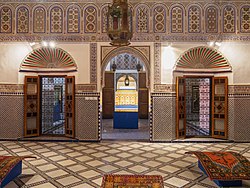
Dar Si Said (Arabic: دار السي سعيد) is a historic late 19th-century palace and present-day museum in Marrakesh, Morocco. It currently houses the National Museum of Weaving and Carpets.[1]
History
[edit]It was built between 1894 and 1900 by Si Sa'id ibn Musa, a vizier and minister of defence under his brother Ba Ahmad ibn Musa, who was the Grand Vizier and effective ruler of Morocco during the same period under Sultan Abdelaziz (ruled 1894–1908).[2][3][4] After 1914, under the French Protectorate administration, the palace served as the seat of the regional leaders of Marrakesh.[4] It was converted into a museum of "indigenous arts" (meaning Moroccan art) and woodcraft in 1930 or 1932.[5][4][6] In 1957, after Moroccan independence, the palace was split into a museum section and a section occupied by the Service de l’Artisanat (Agency of Artisanship).[5][4]
The building has been restored several times since and remains a museum today.[6] Following renovations carried out by the recently created[7] Fondation Nationale des Musées, the museum reopened in 2018 as the National Museum of Weaving and Carpets.[8][9][1]
The museum was significantly damaged by the September 2023 earthquake and was subsequently closed for repairs.[10] As of October 2023, it was estimated that repairs would take at least six months.[11]
Architecture
[edit]The palace's architecture is similar in ornament to the Bahia Palace built further south by his father and his brother, but unlike the latter it is built over more than one level and has a very different layout. Its architectural highlights include a grand reception hall on the upper floor and a large riad garden with a central pavilion of painted wood.[1][3][2]
-
The riad garden
-
Painted decoration inside the wooden pavilion of the garden
-
A courtyard with fountain in the palace
-
One of the grand halls in the palace
-
Cupola over the grand hall
Museum collection
[edit]
The museum collections includes a wide variety of objects, many of them from the southern regions of Morocco.[12] Until recently the museum's exhibits focused on Moroccan wooden art and objects.[12] Its collection included an Andalusi marble basin crafted at Madinat al-Zahra between 1002 and 1007, which was later reused in the Ben Youssef Madrasa,[13] where it was recently returned. Following the museum's reopening in 2018, its current exhibits now focus on weaving and Moroccan carpets.[1][8]
See also
[edit]- Marrakech Museum
- Bahia Palace
- Nejjarine Museum (in Fes)
References
[edit]- ^ a b c d "Dar Si Said | Marrakesh, Morocco Attractions". Lonely Planet. Retrieved 2020-06-04.
- ^ a b Wilbaux, Quentin (2001). La médina de Marrakech: Formation des espaces urbains d'une ancienne capitale du Maroc. Paris: L'Harmattan. p. 289. ISBN 2747523888.
- ^ a b Deverdun, Gaston (1959). Marrakech: Des origines à 1912. Rabat: Éditions Techniques Nord-Africaines. p. 546.
- ^ a b c d "Le Musée Dar Si Saïd | Visiter-Marrakech.com" (in French). 2014-05-23. Retrieved 2021-01-24.
- ^ a b "Musée Dar si Saïd de Marrakech". Fondation nationale des musées (in French). Archived from the original on 2017-12-19. Retrieved 2021-01-24.
- ^ a b Marrakech, Travelguide (2018-01-12). "The Museum Dar Si Said". Travelguide Marrakech. Retrieved 2020-06-04.
- ^ "Fondation nationale des Musées Mehdi Qotbi veut se mettre vite au travail". L'Economiste (in French). 2011-12-21. Retrieved 2021-01-24.
- ^ a b "Ouverture du Musée National du Tissage et du Tapis Dar Si Saïd de Marrakech" (in French). Retrieved 2021-01-24.
- ^ "Après rénovation, le Musée Dar Si Said de Marrakech rouvre ses portes". Médias24. 28 June 2018. Retrieved 1 September 2024.
- ^ "Séisme d'Al Haouz : La FNM à pied d'œuvre pour la réouverture des musées touchés à Marrakech". Maroc.ma (in French). 2023-09-14. Retrieved 2023-10-15.
- ^ Delorme, Anne-Claire (2023-10-07). "Tourisme : un mois après le séisme, Marrakech veut croire en sa bonne étoile". Le Figaro (in French). Retrieved 2023-10-15.
- ^ a b "Dar Si Said (Marrakech, Morocco)". Discover Islamic Art - Virtual Museum. Retrieved 2020-06-05.
- ^ Salmon, Xavier (2016). Marrakech: Splendeurs saadiennes: 1550-1650. Paris: LienArt. p. 134. ISBN 9782359061826.






